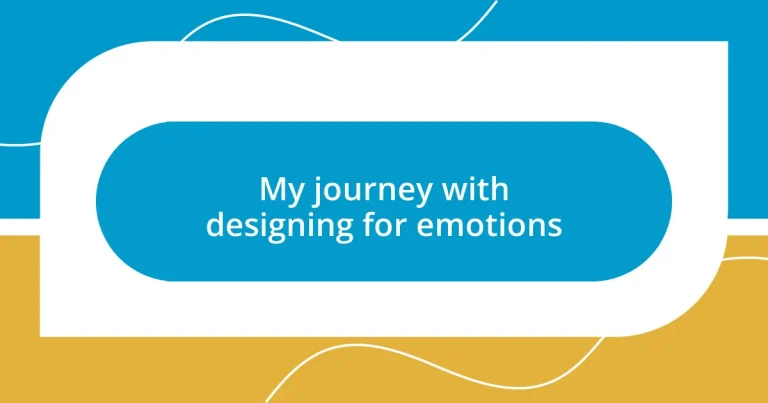Key takeaways:
- Emotional design principles hinge on empathy, nostalgia, and storytelling to forge deep connections with users, enhancing their experience.
- Utilizing strategies like color psychology, personalization, and user feedback can effectively evoke emotions and improve user engagement in design.
- Continuous improvement through user feedback and analytics is essential for maintaining an emotional connection and enhancing user experience over time.
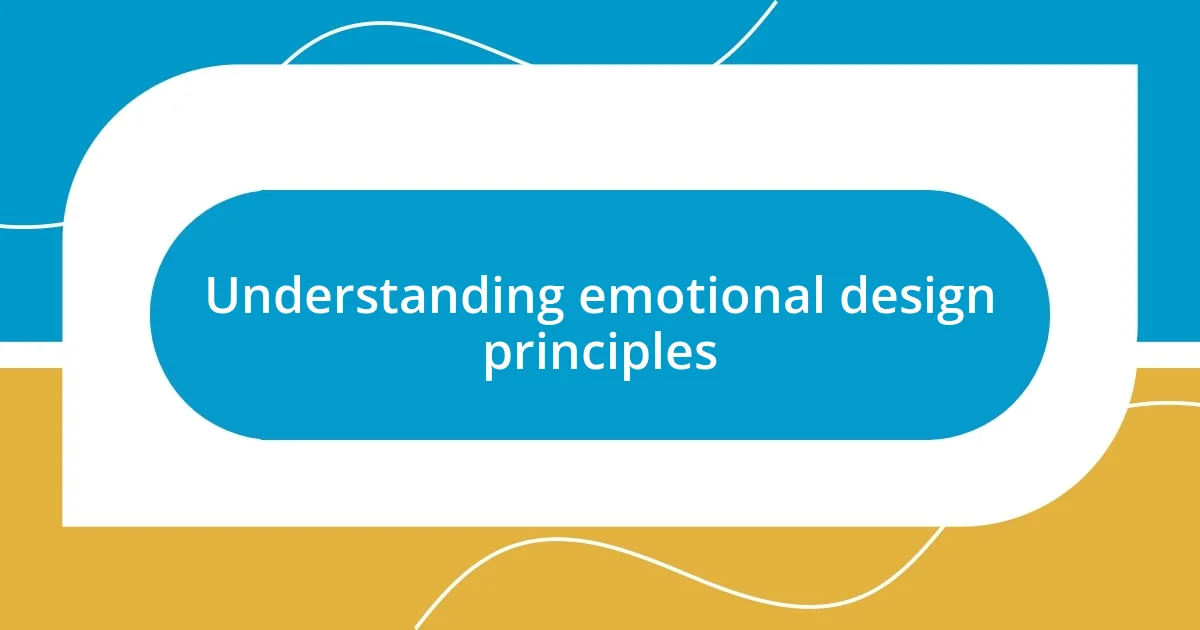
Understanding emotional design principles
Emotional design principles revolve around creating experiences that resonate deeply with users. I vividly remember a project where we focused on nostalgia; incorporating vintage aesthetics and familiar language sparked a strong emotional connection. Have you ever felt that rush of joy when seeing a childhood toy? That’s the kind of response good design aims to evoke.
Another crucial aspect is empathy. I once worked on a mobile app for those with anxiety. Engaging with users to understand their fears and frustrations allowed us to design calming interfaces that truly spoke to their feelings. It’s incredible how just a softer color palette or gentle animations can transform a user’s experience. Can you think of a time when a simple design choice made you feel understood?
Finally, storytelling plays a pivotal role in emotional design. While collaborating on a campaign, we crafted narratives around what our product could offer, emphasizing not just features but the emotional benefits. In this way, users aren’t seeing just a product; they’re experiencing a solution that aligns with their aspirations. Doesn’t it often feel more impactful to connect with a brand on a personal level?
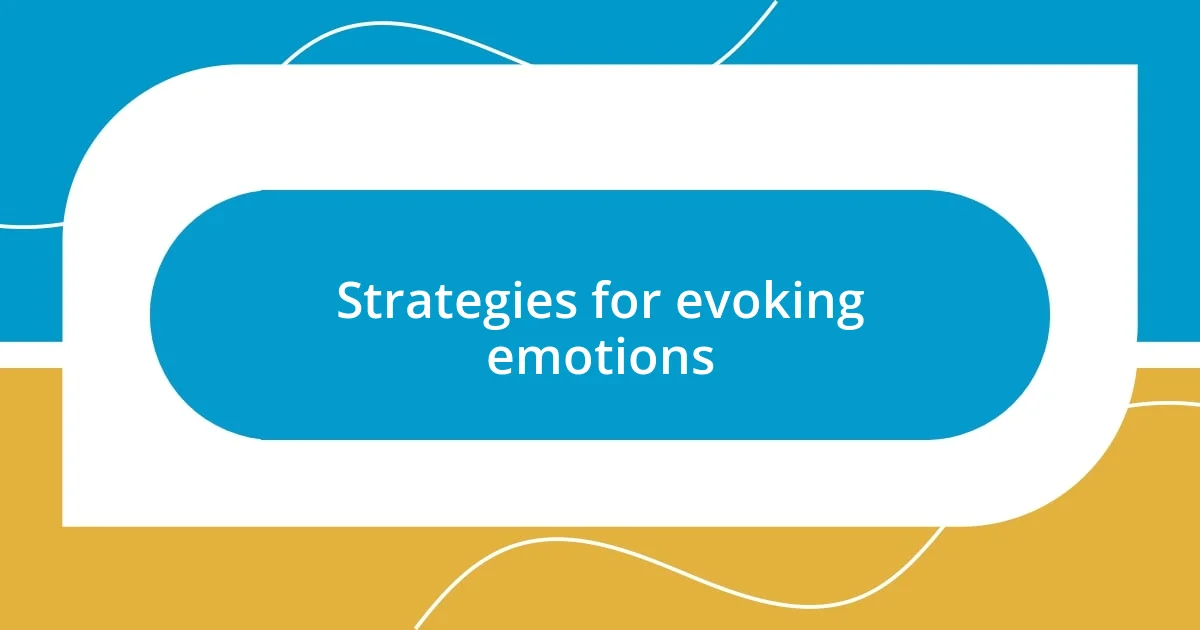
Strategies for evoking emotions
Creating emotional connections through design requires intentional strategies that resonate with users. In my experience, using color psychology has proven particularly effective. For instance, I once designed an event invitation with warm, inviting colors that reminded people of sunset gatherings. The feedback was overwhelming—the colors had stirred feelings of nostalgia and excitement, prompting attendees to reminisce about memorable times with friends and family.
Here are some strategies I recommend for evoking emotions in design:
- Color Choices: Use colors that evoke particular feelings; for example, blue for calmness or red for excitement.
- Personalization: Allow users to customize elements, creating a sense of ownership that fosters emotional attachment.
- Imagery and Icons: Select images that tell a story or evoke specific memories, making sure they resonate with your target audience.
- Sensory Elements: Integrate soundscapes or tactile features that align with the intended emotional experience.
- User Feedback: Actively seek user input to understand their emotional responses better and iterate on designs that reflect those sentiments.
Throughout my design journey, I’ve continually seen how small shifts can lead to profound emotional responses. For instance, during a project aimed at enhancing user engagement on a website, I felt compelled to incorporate user-generated content. Seeing real stories shared by users not only boosted trust but created a community vibe that genuinely connected people. Have you ever felt inspired by someone else’s story? Harnessing that power in design is a game-changer.
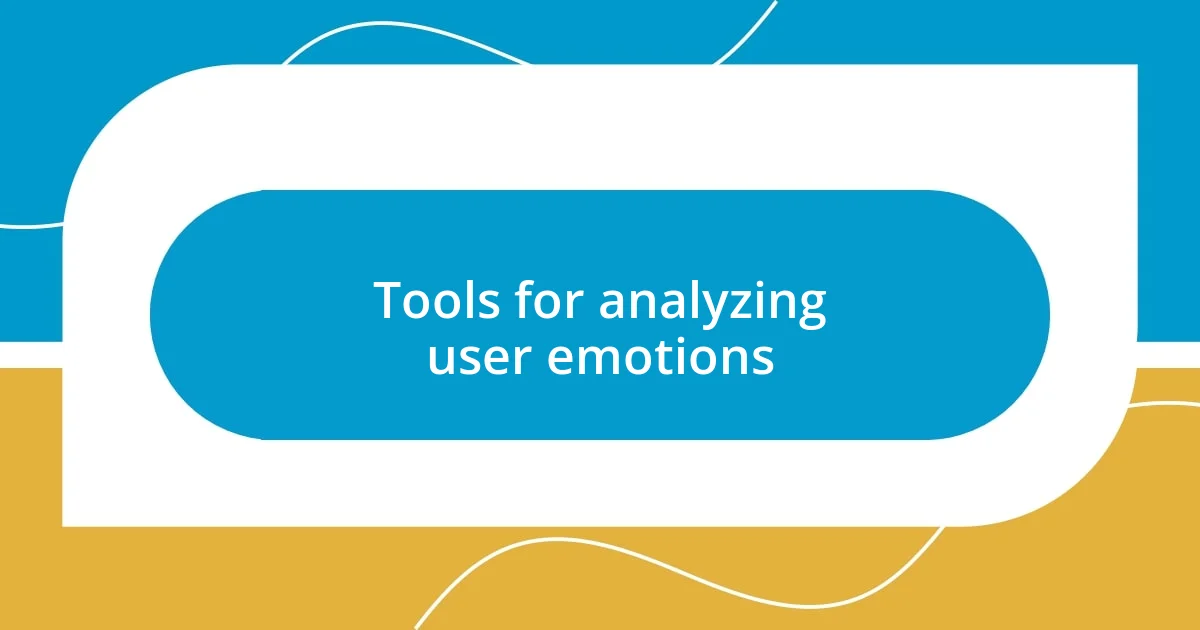
Tools for analyzing user emotions
Tools for analyzing user emotions are essential in understanding the emotional responses of your audience. During a project involving a fitness app, I used sentiment analysis tools to evaluate user feedback. The insights we gathered helped us identify not just what users liked, but the deeper feelings driving their experiences, such as motivation or disappointment.
In my experience, usability testing combined with emotion metrics can be tremendously effective. For instance, during a website redesign, we utilized tools like eye-tracking technology to see where users focused their attention. This not only highlighted areas that resonated well but also revealed moments of confusion, allowing us to tweak the design for better emotional alignment. Have you considered how user attention can inform emotional design?
Lastly, biometric tools, such as facial coding or wearable tech, provide another layer of insight. I once experimented with emotion recognition software during a user-testing session. The emotional tailing in the tests showed genuine reactions that words alone failed to capture. It enriched our understanding of how users connect, react, and feel while using a product. What’s more powerful than seeing raw emotional responses to your designs?
| Tool | Description |
|---|---|
| Sentiment Analysis | Analyzes user feedback to gauge emotional responses through language. |
| Usability Testing with Emotion Metrics | Combines user interaction with emotional tracking to refine design elements. |
| Biometric Emotion Recognition | Measures users’ emotions through facial expressions or physiological responses during interaction. |
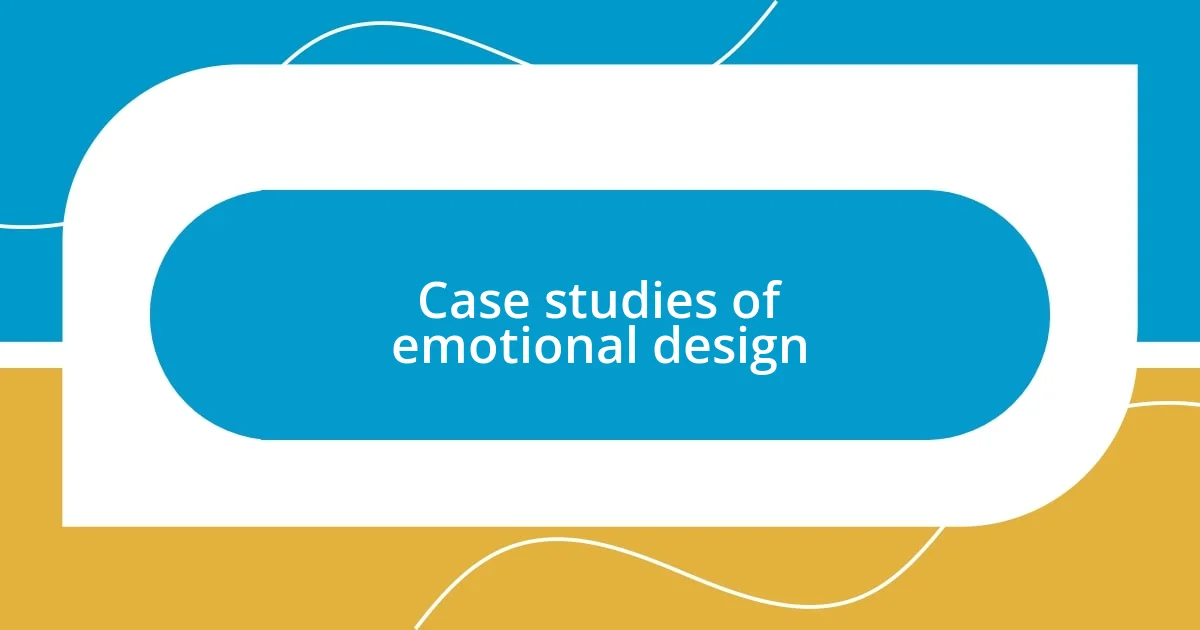
Case studies of emotional design
One of my favorite case studies in emotional design involved a mobile app that aimed to improve users’ mental well-being. We decided to implement a feature where users could log not only their mood but also the reasons behind it. I vividly recall the moment we conducted a feedback session—users expressed how this simple act of reflection made them feel heard and validated. Have you ever experienced that sense of relief when you could share your feelings? That emotional engagement turned the app into more than just a tool; it became a companion in their journey.
Another great example is a website redesign for a nonprofit focused on community support. By collecting stories from beneficiaries and integrating them into the site’s design, we created a narrative tapestry showcasing their impact. I remember watching the team react emotionally during usability testing. Users felt a genuine connection to these stories, which made them more likely to engage and contribute. Isn’t it interesting how real-life narratives can foster empathy and drive action?
Lastly, I worked on an e-commerce platform where we experimented with a personalized greeting for returning users. The design featured an engaging animation that not only welcomed them back but also highlighted products based on previous purchases. What struck me was the feedback—many users shared that it felt like coming home to a familiar place. This simple yet effective tactic strengthened loyalty and transformed a transactional experience into a personal one. How often do we overlook the power of recognition in building emotional bonds?
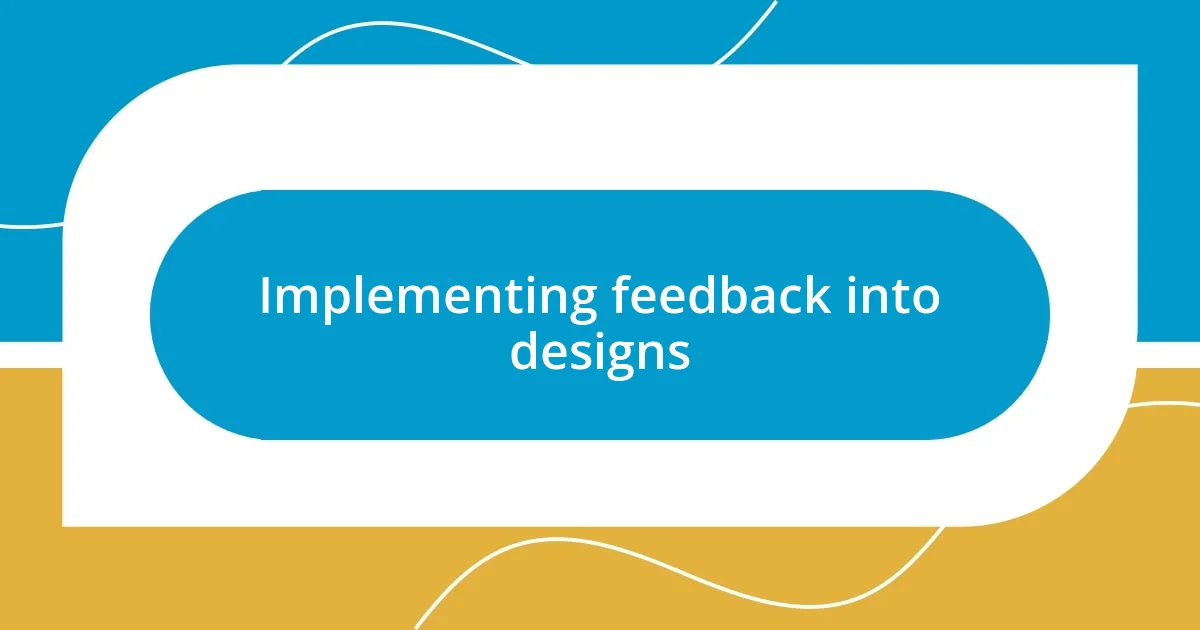
Implementing feedback into designs
Integrating feedback into designs is a crucial aspect of the creative process. In one project, I implemented a series of feedback loops that allowed users to voice their opinions throughout the design stages. I remember the moment a user pointed out an overlooked feature; it not only shaped the final product but also made them feel like co-designers. Isn’t it amazing how actively involving users can create deeper emotional connections?
During design revisions for a travel app, I learned the hard way the value of truly listening to user feedback. After receiving initial critiques, I took the time to analyze users’ pain points, particularly around the booking flow. I adjusted the layout based on their suggestions and noticed a significant increase in satisfaction scores. Have you ever had a moment where a minor change transformed the user experience entirely?
Moreover, I’ve found that sometimes feedback doesn’t come from direct comments but rather from observing user interactions. In a recent project involving a health tracking app, we printed out user journeys and physically rearranged sticky notes based on insights from testing sessions. This visual method revealed underlying emotional trends, sparking discussions that led to innovative design solutions. How often do we overlook the subtle cues that users provide through their actions? It’s a reminder that feedback can be a powerful catalyst for emotional design, leading to a product that resonates with users on a deeper level.
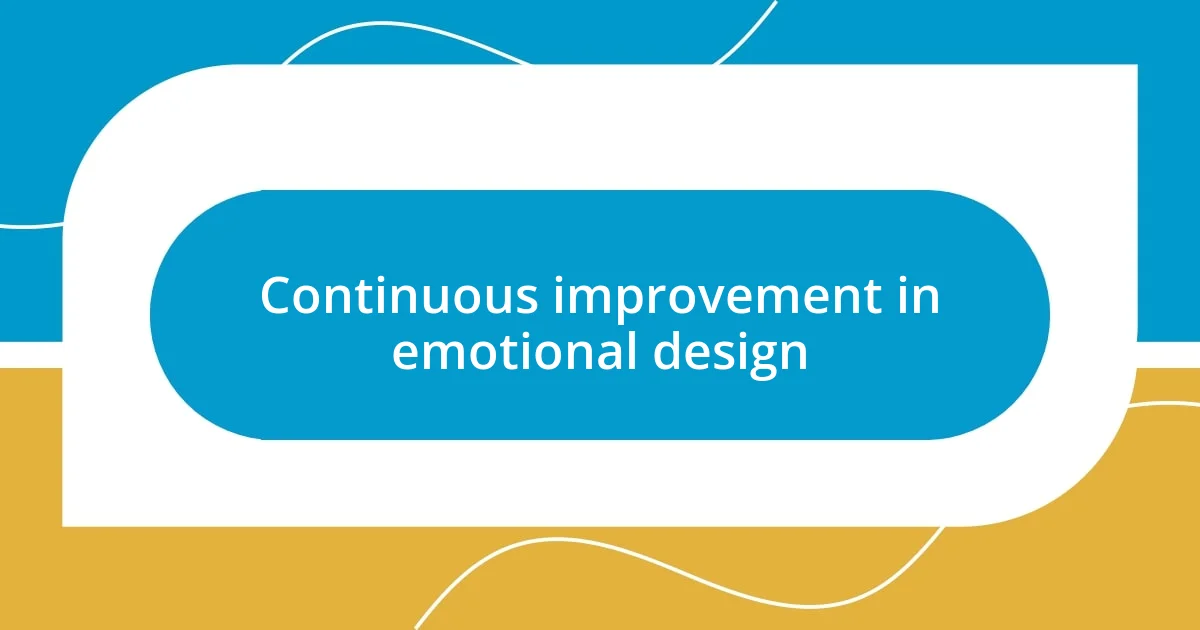
Continuous improvement in emotional design
I’ve come to realize that continuous improvement in emotional design isn’t a one-time effort; it’s an ongoing journey. In a past project, I started incorporating regular check-ins with users even after the initial launch. I still remember how a few small changes based on user feedback had a profound impact on their emotional connection with the product. Have you ever thought about how even minor adjustments can enhance someone’s experience? It’s about evolving alongside our users.
One experience that stands out involved a fitness app I was developing. After launching a feature to celebrate users’ milestones, I gathered feedback through in-app surveys and focus groups. I was amazed when users shared that these little celebrations made them feel like they were part of a community, rather than just isolated individuals tracking their fitness goals. This insight truly highlighted the importance of acknowledging emotional touchpoints in design. Isn’t it empowering to see how design can foster a sense of belonging?
Moreover, I find it fascinating how user behavior can guide emotional design improvements. In one project, we used analytics to track how users interacted with a meditation app. The data revealed that the most engaged users often interacted with specific calming visuals. This sparked discussions within the team to revise our design, leading to the introduction of more soothing imagery and sounds. Have you ever felt the calming effect of a beautifully designed interface? It’s a powerful reminder of how closely intertwined design and emotion can be, pushing us to keep refining our approach.












